#Basics of Frontend Technologies
Explore tagged Tumblr posts
Text
#Evolution of Frontend Technologies#Top Frontend Technologies#Basics of Frontend Technologies#Frontend Technologies for App Development#Frontend Technologies for Mobile App Development
1 note
·
View note
Text
0 notes
Note
woah! just saw your bio change to software engineer. how did you transition? is it any different than web dev?
i also went on a TikTok rabbit hole and people are saying it’s useless to learn html/css and it’s not an actual language. honestly idk why I thought it would be easy to learn html > css > javascript > angular > react and somehow land a good paying job…
it’s gonna take YEARS for me to have a career, i feel old… especially with no degree

Hiya! 🩶
This is a long reply so I answered your question in sections below! But in the end, I hope this helps you! 🙆🏾♀️

🔮 "How did you transition?"
So, yeah my old job title was "Junior Web Developer" at a finance firm, and now my new title is "Frontend Software Engineer"! In terms of transition, I didn't make too much of a change.
After I quit my old job, I focused more on Frontend technologies that were relevant, so I focused on React.js and Node.js. I used YouTube, books, and Codeacademy. My first React project was >> this Froggie project <<~! Working on real-life projects such as the volunteering job I did (only for a month) where they used the technologies I was learning. So basically I did this:
decides to learn react and node 🤷🏾♀️
"oh wait let me find some volunteering job for developers where they use the tech I am learning so I can gain some real-life experience 🤔"
experienced developers in the team helped me with other technologies such as UI tools, and some testing experience 🙆🏾♀️
I did the volunteering work for both fun and learning with experienced developers and... I was bored and wanted to feel productive again... 😅
So for transitioning, I focused on learning the new technologies I wanted to work in and got some work experience (though it was volunteering) to back up if I can work in an environment with the tech. I still live with my family so I could do the volunteering job and have time to self-study whilst being okay financially (though I was tight with money haha) 😅👍🏾
🔮 "Is it any different than web dev?"
The old job was focused on using C# and SQL (including HTML, CSS, and JavaScript but fairly small) to make the websites, they were fairly basic websites for clients to use just to navigate their information needed. They weren't fancy cool web design because they didn't need to be, which was what made me bored of the job and wanted a change.
I am only a week into the job and have been working on small tickets (features for the site), but I think after a month or two into the job I will make a proper judgment on the difference~! So far, it's kind of the same thing I did in my old job but with new workflow tools, React-based projects, and funny people to work with 😅🙌🏾
🔮 "People are saying it’s useless to learn HTML/CSS and it’s not an actual language."
Yes HTML is a markup language and CSS is a stylesheet but they are the foundation of like 90% of the websites on the internet, I wouldn't ever call them "useless". Frameworks such as React, Django, Flask, etc still require HTML and CSS code to make the website's structure and styling. CSS frameworks like Tailwind and Bootstrap 5 still use CSS as their base/foundation. Not useless at all.
Don't focus on what other people are doing and focus on your own learning. I repeat this all the time on my blog. Just because one or a couple people online said one technology is useless doesn't mean it is (this is applied to most things in tech). Someone told me jQuery was entirely useless and no bother learning it - I did it anyway and it helped me better understand JavaScript. Anyhoo, try things YOURSELF before listening to what people say - make your own judgment. Not going to let a random Tech bro online whine about how annoying Python or C or whatever is to ruin my want to learn something. (This is all coming from a girl who loves web development very much's point of view :D)
🔮 "I thought it would be easy to learn html > css > javascript > angular > react and somehow land a good paying job"
Web Dev route, I love it! That's literally the same steps I would have taken if I had to start again~! For each new tech you learn, make a bunch of projects to 1) prove to yourself that you can apply what you've learned 2) experience 3) fill that portfolio~! 😎🙌🏾
With Angular and React, I would pick one or the other and focus on being really good at it before learning another framework!
I also recommend volunteering jobs, freelancing, helping a small business out with free/paid m
Lastly, you do not need a degree to get a job in Web Development. I mean look at me? My apprenticeship certificate is the same value as finishing school at 18, so in the UK it would be A-Levels, and I completed it at the ripe age of 21! I have no degree, I applied for university and got a place but I will give that space up for someone else, I'm not ready for university just yet! haha... (plus erm it's expensive at the end, what? even for the UK...). Sure, I used to avoid the job postings that were like "You need a computer science degree" but now if I were job searching I would apply regardless.
People switching careers in their 40s going into tech instead are making it, you can switch anytime in your lifetime if you have the means to! (everyone's situation is different I understand).
I'm not too good at giving advice but I hope in the rambling I made some sense? But yeah that's all! 😎
#my asks#codeblr#coding#progblr#programming#studyblr#studying#computer science#tech#comp sci#programmer#career advice#career#career tips
19 notes
·
View notes
Text
Binance clone script — Overview by BlockchainX
A Binance Clone Script is a pre-built, customizable software solution that replicates Binance's features, connect with BlockchainX
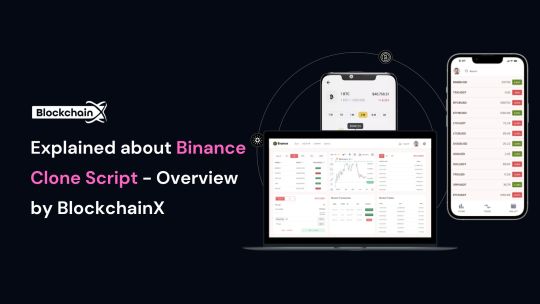
What is Binance Clone Script
A Binance clone script refers to the ready-made solution of the Binance platform that deals with core functions parallel to the widely acclaimed cryptocurrency exchange platform associated with Binance. It enables companies to establish their own platforms like Binance, perfectly parameterized in terms of functionality and user interface of world-famous exchanges. The clone script provides display flexibility with built-in functionality such as spot trading software, futures trading configurations, and wallet systems that are extremely secure.
Basically, it reduces development costs and latency because things like these are already built. And as this is a startup for many young entrepreneurs, they can have saved on their capital to expand or grow their business.
The script is blessed as its feature set caters to future demands in the field. One can enjoy a safe trading experience to customers while ensuring that every peculiarity of Binance’s success opens up to investors of the script.
How does the Binance clone script work?
The Binance clone script works to provide a ready-made platform that replicates Binance’s core features, such as user registration, wallet management, trade and enables users to create accounts, deposit or withdraw cryptocurrency, and trade digital assets through an interface easily and safely. The platform supports various trading methods such as market orders, limit orders and forward trading. It has built-in security features like two-factor authentication (2FA) to save the user money. Admin dashboards allow platform owners to manage users, manage tasks, and set up billing. The script can be tailored to your brand, connecting liquidity sources to make trading more efficient. In short, the Binance clone script provides everything needed to create a fully functional crypto exchange.
key features of a Binance Clone Script
The key features of a Binance Clone Script are designed to make your cryptocurrency exchange platform secure, user-friendly, and fully functional. Here’s a simple overview of these features:
User-Friendly Interface
Multi-Currency Support
Advanced Trading Engine
Secure Wallet System
KYC/AML Integration
Admin Dashboard
Security Features
Trading Options
These features help ensure that your Binance-like exchange is efficient, secure, and ready for the growing crypto market.
Technology Stack Used by BlockchainX
Technology stack used for developing the Binance clone script involves the most advanced technology combination that ensures that the platform must have so much security, scalability, and performance to make it a platform that is secure, scalable, and high-performance as well. Here are a few key technologies and their brief descriptions:
Blockchain Technology:
The underlying part of the cryptocurrency exchange is Blockchain because it ensures the safe and decentralized processing of transactions.
Normally executed on either Ethereum or BSC (Binance Smart Chain) to carry out smart contracts and token transfers.
Programming Languages:
Frontend: For frontend, React or Angular could be engaged in actualization of the user interface leading to a responsive and interactive experience on the various devices.
Backend: In backend, languages like Node.js, Python, or Ruby on Rails can be applied on how internal logic is being run by server and arbitration of user interaction with the module is foremost.
Databases:
These two databases, MySQL or Postgresql, are typically used in user information storage, transaction records, and other exchange information.
NoSQL such as MongoDB or other databases might be used for horizontal scalability and high-volume transaction storage.
Smart Contracts:
It is used to generate and send out smart contracts for auto-trading, token generation, and other decentralized functionalities.
Blockchain Wallets:
Fundamentally, this automatically links famous wallet systems such as MetaMask, Trust Wallet, or Ledger for the secure storage and transactions of cryptocurrency.
Advantages of using a Binance Clone Script
Here are the advantages of using a Binance Clone Script:
Faster Time-to-Market
Cost-Effective
Customizable Features
Liquidity Integration
Multiple Trading Options
So, when entering the marketplace of the cryptocurrencies it would be the most possible work of something to pay off at a rapid pace: the Binance Clone Script proves so.
How to Get Started with BlockchainX’s Binance Clone Script
It is quite a straightforward process to begin working with a BlockchainX Binance Clone Script-this involves the first step of getting in touch with the company for an initial consulting period to understand more about what you require, need, or customize for the site, and what your goals are. When BlockchainX has an understanding of your needs, they offer a detailed list of what a proposal would entail before they can start the work; afterward, they will estimate the costs needed to do the project. Once both sides accept both the presentations and all features and timelines are agreed with, BlockchainX starts working on the development process of building a Binance Clone Script tailored to the brand, user interface, and other features.
After the entire platform is created, it passes through severe testing to ensure that everything functions excellently. Deployment follows the thorough test. BlockchainX customizes your user interface and more extensions, after deployment. BlockchainX also commits to supporting and sustaining your exchange so that it runs successfully and securely.
Conclusion:
At the end, your confusion may as well be cut short. Yes, the Binance Clone Script will be a resilient solution to spark up the exchange platforms synthesizing user-generated cryptocurrency dreams in the blockchain, even without bankroll when it comes to developing the app. Turning with BlockchainX expertise, you can make an adjustment and scale a powerful platform stocked with the likes of Binance that produced Blockchains, while still containing some specific set-ups for your masterpiece. More amazing features are exclusive to the clone script, moreover, such as support for multiple currencies, high-end security, real-time data, and a smooth user interface that completes the trading process for your users without any glitch.
This solution gives easy access to ready-made solutions. It could have quality Depending on the time you conveniently let BlockchainX’s be and use both exchanges or any variation of the two permutations. After all, who decides to couple up with a one-experienced Crypto Exchange developer who is struggling to offer anything new.
#binance clone script#binance clone script development#binance clone script development service#blockchain technology#blockchain#cryptocurrency#cryptocurrencies
2 notes
·
View notes
Text
The Roadmap to Full Stack Developer Proficiency: A Comprehensive Guide
Embarking on the journey to becoming a full stack developer is an exhilarating endeavor filled with growth and challenges. Whether you're taking your first steps or seeking to elevate your skills, understanding the path ahead is crucial. In this detailed roadmap, we'll outline the stages of mastering full stack development, exploring essential milestones, competencies, and strategies to guide you through this enriching career journey.

Beginning the Journey: Novice Phase (0-6 Months)
As a novice, you're entering the realm of programming with a fresh perspective and eagerness to learn. This initial phase sets the groundwork for your progression as a full stack developer.
Grasping Programming Fundamentals:
Your journey commences with grasping the foundational elements of programming languages like HTML, CSS, and JavaScript. These are the cornerstone of web development and are essential for crafting dynamic and interactive web applications.
Familiarizing with Basic Data Structures and Algorithms:
To develop proficiency in programming, understanding fundamental data structures such as arrays, objects, and linked lists, along with algorithms like sorting and searching, is imperative. These concepts form the backbone of problem-solving in software development.
Exploring Essential Web Development Concepts:
During this phase, you'll delve into crucial web development concepts like client-server architecture, HTTP protocol, and the Document Object Model (DOM). Acquiring insights into the underlying mechanisms of web applications lays a strong foundation for tackling more intricate projects.
Advancing Forward: Intermediate Stage (6 Months - 2 Years)
As you progress beyond the basics, you'll transition into the intermediate stage, where you'll deepen your understanding and skills across various facets of full stack development.

Venturing into Backend Development:
In the intermediate stage, you'll venture into backend development, honing your proficiency in server-side languages like Node.js, Python, or Java. Here, you'll learn to construct robust server-side applications, manage data storage and retrieval, and implement authentication and authorization mechanisms.
Mastering Database Management:
A pivotal aspect of backend development is comprehending databases. You'll delve into relational databases like MySQL and PostgreSQL, as well as NoSQL databases like MongoDB. Proficiency in database management systems and design principles enables the creation of scalable and efficient applications.
Exploring Frontend Frameworks and Libraries:
In addition to backend development, you'll deepen your expertise in frontend technologies. You'll explore prominent frameworks and libraries such as React, Angular, or Vue.js, streamlining the creation of interactive and responsive user interfaces.
Learning Version Control with Git:
Version control is indispensable for collaborative software development. During this phase, you'll familiarize yourself with Git, a distributed version control system, to manage your codebase, track changes, and collaborate effectively with fellow developers.
Achieving Mastery: Advanced Phase (2+ Years)
As you ascend in your journey, you'll enter the advanced phase of full stack development, where you'll refine your skills, tackle intricate challenges, and delve into specialized domains of interest.
Designing Scalable Systems:
In the advanced stage, focus shifts to designing scalable systems capable of managing substantial volumes of traffic and data. You'll explore design patterns, scalability methodologies, and cloud computing platforms like AWS, Azure, or Google Cloud.
Embracing DevOps Practices:
DevOps practices play a pivotal role in contemporary software development. You'll delve into continuous integration and continuous deployment (CI/CD) pipelines, infrastructure as code (IaC), and containerization technologies such as Docker and Kubernetes.
Specializing in Niche Areas:
With experience, you may opt to specialize in specific domains of full stack development, whether it's frontend or backend development, mobile app development, or DevOps. Specialization enables you to deepen your expertise and pursue career avenues aligned with your passions and strengths.
Conclusion:
Becoming a proficient full stack developer is a transformative journey that demands dedication, resilience, and perpetual learning. By following the roadmap outlined in this guide and maintaining a curious and adaptable mindset, you'll navigate the complexities and opportunities inherent in the realm of full stack development. Remember, mastery isn't merely about acquiring technical skills but also about fostering collaboration, embracing innovation, and contributing meaningfully to the ever-evolving landscape of technology.
#full stack developer#education#information#full stack web development#front end development#frameworks#web development#backend#full stack developer course#technology
9 notes
·
View notes
Text
PMT01: Scaffold nano & Trowel pico
Scaffold nano & Trowel pico v1.1.0 have been released tonight.
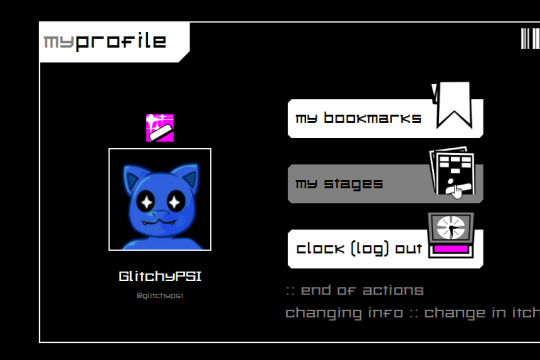

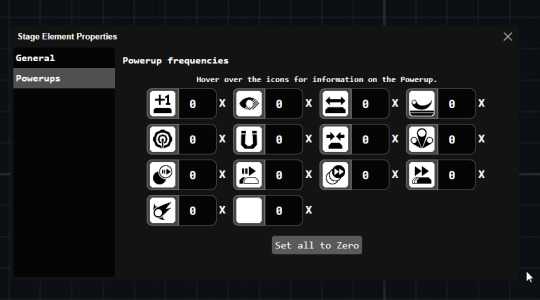
Updates add a myStages to Scaffold, and QoL improvements to the powerup editing experience in Trowel pico.
Now that it's out, I'd like to also take this moment to talk about the development and release of both.
One year minus one day ago I had announced in Twitter I would work on the level editor for the demo version of BRICKBREAKER SPRINT (nano) so fans could breathe in more life to the game even in its limited state and to also showcase how much it can do with its limited toolset at the current time.
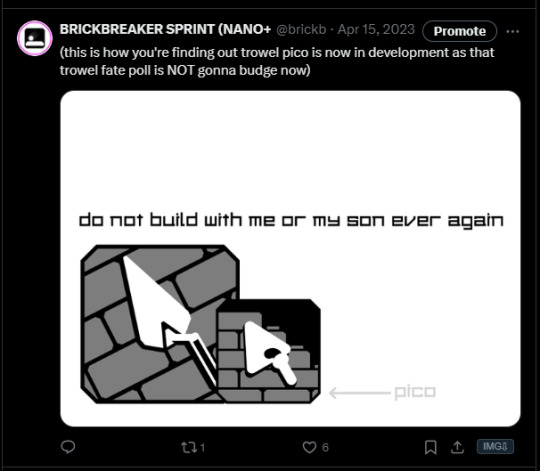
The reasoning for a completely separate technology version was simple, WebGL. WebGL in Unity is so limited for even the most basic things (I had to install a package to support cross-app copy/paste before nano+'s release!) and I said "hey, might as well give the multiplatform users something to be able to edit with, doesn't need to be just windows which is what the currently unpolished-ish trowel desktop is!"
But then it hit me that the same limitations would likely make it hell for me to support just levels downloaded as files (internally stored with "bxtp" extension btw :) ) so then... I came at a crossroads
just say FKIT and not do it, make ppl wait for BB Lite
still say FKIT and kickstart the foundation of the online service that I had planned since the first design iteration of the game
guess what I took?
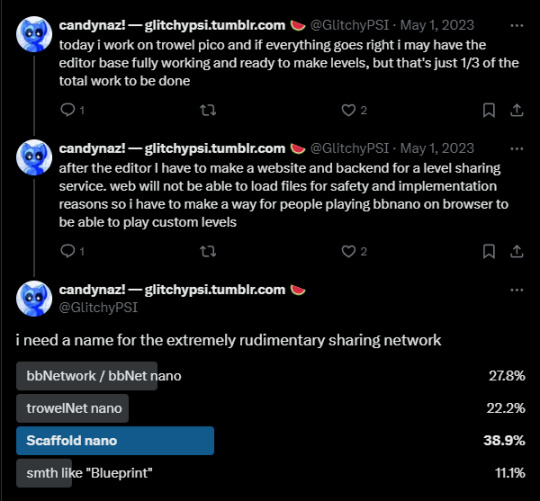
I don't regret it.
Currently, Scaffold's login system is attached to itch.io. In the future, this will use my own account system (called Luna, still in development)
Now then... developing Scaffold's frontend was a challenge in itself, because I'm a masochist. I chose yet another technology to make the frontend in, this time Svelte, Sveltekit as backend saying "okay, no more fear of ServerSideRendering now that I can afford a VPS for this"
but... Svelte has been an absolute joy to work with. Its learning curve even smoother than React's (my first frontend framework, which powers cometSpectrum!), and I got everything rolling very quickly
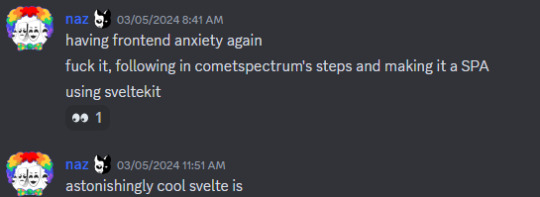
At first, I was going to use my regular website design language, but it's kinda jank, so I said NO and started from scratch with a simpler façade. For the style I wanted to pursue... it was perfect. Some people have complimented the graphic aspect of the site, and I'm happy I could deliver exactly what I wanted. (and yes the icons being in opposite directions compared to bbsprint's UI is entirely on purpose)
BTW, the site is made in such a way that a BB theme could be used as the site's theme and every color will change except for PNG icons, i love it (this functionality is used for people using their OS's Light theme)
This is actually the first made-by-me website project that has "public" facing write actions to a database and stores actual files. It works... very well, and I am very happy about it. It's like a combination of everything I've learnt up to this point, down to API design and interop between programs.
I did say this was the foundation for Scaffold, and I plan for this game to keep Scaffold as its prime way of getting stages, even when getting to storefronts like Steam or GOG. Kind of like an osu! situation.
You're at this part of the message... wanna see how Scaffold's logo used to look like?
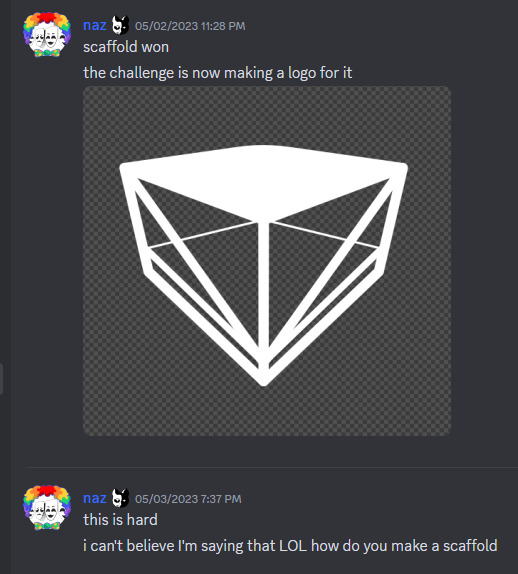
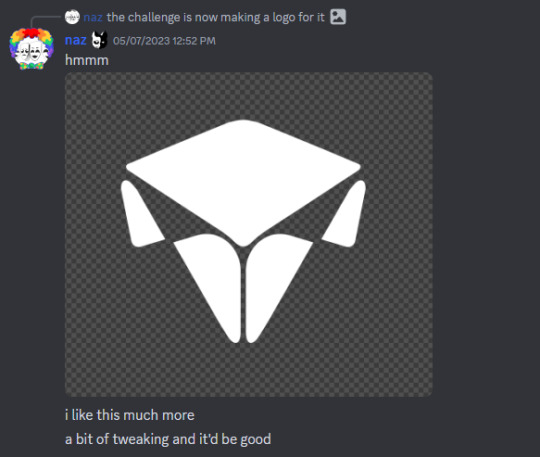
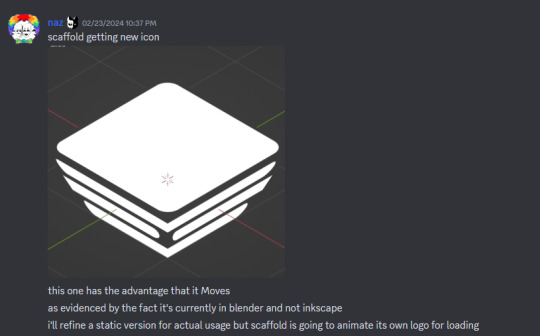
5 notes
·
View notes
Text
Frontend Technologies (React.js and Angular.js)
Ever since the advent of the world wide web, technologies have been researched and created to streamline the creation of Web pages that are displayed to a client upon the client's request. These web pages began by being static and non-interactive with the use of basic HTML and CSS. After awhile, the Javascript programming language stormed the world of web applications and brought a layer of interactivity, finesse, and dynamism to web applications. Since then, more technologies, most of which are built on the basic initial technologies, have come out. Two of the most popular and effective technologies are React.js and Angular.js. In this article, an attempt would be made to highlight the differences in these technologies and what makes them unique and powerful.
Firstly, React.js is built on Javascript and produced and managed by Meta while Angular is also built on TypeScript but it was produced and managed by Google.
React is a Javascript library while Angular is a framework.
React makes use of a "templating langauge" called JSX to extend Javascript into HTML and it is rendered in the server side while Angular extends the functionality of HTML by adding more attributes like "ng-bind" and it is client side rendered.
React works by using a virtual DOM, while Angular uses the real DOM.
React is a highly scalable library because of the reusability of its components while Angular is less Highly scalable.
Having itemised these differences, they each have their strengths and what makes developers prefer one over the other. React has support for mobile App development, reusability and predictability of code, one can learn it really fast Etc. Angular has faster server side rendering, fewer lines of code, takes time to learn, Etc.
I specifically prefer React to Angular which is why I am glad that React is being used in the HNG internship https://hng.tech/internship where I am currently interning. I have used React to build highly interactive web applications and look forward to honing my skills better as I use it for more daunting projects in the HNG internship. Check out HNG on their website https://hng.tech/premium
2 notes
·
View notes
Text
The Ultimate Guide to Web Development
In today’s digital age, having a strong online presence is crucial for individuals and businesses alike. Whether you’re a seasoned developer or a newcomer to the world of coding, mastering the art of web development opens up a world of opportunities. In this comprehensive guide, we’ll delve into the intricate world of web development, exploring the fundamental concepts, tools, and techniques needed to thrive in this dynamic field. Join us on this journey as we unlock the secrets to creating stunning websites and robust web applications.
Understanding the Foundations
At the core of every successful website lies a solid foundation built upon key principles and technologies. The Ultimate Guide to Web Development begins with an exploration of HTML, CSS, and JavaScript — the building blocks of the web. HTML provides the structure, CSS adds style and aesthetics, while JavaScript injects interactivity and functionality. Together, these three languages form the backbone of web development, empowering developers to craft captivating user experiences.
Collaborating with a Software Development Company in USA
For businesses looking to build robust web applications or enhance their online presence, collaborating with a Software Development Company in USA can be invaluable. These companies offer expertise in a wide range of technologies and services, from custom software development to web design and digital marketing. By partnering with a reputable company, businesses can access the skills and resources needed to bring their vision to life and stay ahead of the competition in today’s digital landscape.
Exploring the Frontend
Once you’ve grasped the basics, it’s time to delve deeper into the frontend realm. From responsive design to user interface (UI) development, there’s no shortage of skills to master. CSS frameworks like Bootstrap and Tailwind CSS streamline the design process, allowing developers to create visually stunning layouts with ease. Meanwhile, JavaScript libraries such as React, Angular, and Vue.js empower developers to build dynamic and interactive frontend experiences.
Embracing Backend Technologies
While the frontend handles the visual aspect of a website, the backend powers its functionality behind the scenes. In this section of The Ultimate Guide to Web Development, we explore the world of server-side programming and database management. Popular backend languages like Python, Node.js, and Ruby on Rails enable developers to create robust server-side applications, while databases such as MySQL, MongoDB, and PostgreSQL store and retrieve data efficiently.
Mastering Full-Stack Development
With a solid understanding of both frontend and backend technologies, aspiring developers can embark on the journey of full-stack development as a Software Development company in USA. Combining the best of both worlds, full-stack developers possess the skills to build end-to-end web solutions from scratch. Whether it’s creating RESTful APIs, integrating third-party services, or optimizing performance, mastering full-stack development opens doors to endless possibilities in the digital landscape.
Optimizing for Performance and Accessibility
In today’s fast-paced world, users expect websites to load quickly and perform seamlessly across all devices. As such, optimizing performance and ensuring accessibility are paramount considerations for web developers. From minimizing file sizes and leveraging caching techniques to adhering to web accessibility standards such as WCAG (Web Content Accessibility Guidelines), every aspect of development plays a crucial role in delivering an exceptional user experience.
Staying Ahead with Emerging Technologies
The field of web development is constantly evolving, with new technologies and trends emerging at a rapid pace. In this ever-changing landscape, staying ahead of the curve is essential for success. Whether it’s adopting progressive web app (PWA) technologies, harnessing the power of machine learning and artificial intelligence, or embracing the latest frontend frameworks, keeping abreast of emerging technologies is key to maintaining a competitive edge.
Collaborating with a Software Development Company in USA
For businesses looking to elevate their online presence, partnering with a reputable software development company in USA can be a game-changer. With a wealth of experience and expertise, these companies offer tailored solutions to meet the unique needs of their clients. Whether it’s custom web development, e-commerce solutions, or enterprise-grade applications, collaborating with a trusted partner ensures seamless execution and unparalleled results.
Conclusion: Unlocking the Potential of Web Development
As we conclude our journey through The Ultimate Guide to Web Development, it’s clear that mastering the art of web development is more than just writing code — it’s about creating experiences that captivate and inspire. Whether you’re a novice coder or a seasoned veteran, the world of web development offers endless opportunities for growth and innovation. By understanding the fundamental principles, embracing emerging technologies, and collaborating with industry experts, you can unlock the full potential of web development and shape the digital landscape for years to come.
2 notes
·
View notes
Text
How to Build a Zomato Clone App: A Step-by-Step Guide

Building a successful food delivery app like Zomato requires careful planning and execution. With the growing demand for convenient and seamless food delivery services, developing a Zomato clone app can be a lucrative business opportunity. In this step-by-step guide, we will walk you through the process of building your own Zomato clone app, from market research and design to development and launch.
Whether you are an aspiring entrepreneur or an existing restaurant owner looking to expand your business, this guide will provide you with all the information you need to create a successful food delivery app and tap into the booming food delivery industry.
Here's a step-by-step guide to help you build a Zomato-like app:
Market Research
Understand your target audience and market. Analyze Zomato and other similar apps to identify features and functionalities.
Legal Compliance
Check local laws and regulations related to food delivery and online platforms. Obtain necessary licenses and permissions.
Define Features
List the features you want in your app, such as user registration, restaurant listing, menu display, reviews, ratings, order placement, payment processing, etc.
Choose Technology Stack
Select the technology stack for your app (front-end and back-end frameworks, database, etc.).
Wireframing and Design
Create wireframes to outline the app's structure. Design the user interface (UI) and user experience (UX).
Backend Development
Set up the server and database. Implement user authentication, authorization, and data storage.
Frontend Development
Based on the design, create the user interface. Implement features like user registration, restaurant listing, menu display, and order placement.
Integrate Maps and Location Services
Use mapping APIs to provide location-based services for finding restaurants and tracking deliveries.
Implement Search and Filters
Allow users to search for restaurants based on various criteria like cuisine, location, ratings, etc.
User Reviews and Ratings
Implement an application for users to submit restaurant reviews and ratings.
Order Placement and Checkout
Develop a seamless and secure process for users to place orders and make payments.
Notifications
Set up push notifications to keep users informed about order status, promotions, etc.
Payment Integration
Integrate secure payment gateways for seamless transactions.
Testing
Perform extensive testing to investigate and fix bugs. Check out the app on different devices and screen sizes.
Deployment
Launch the app to the App Store and Google Play Store.
Monitor and Maintain
Monitor app performance and address any issues promptly. Maintain the app's security patches.
Building a Zomato clone app requires a strategic approach, technical proficiency, and a commitment to delivering an outstanding user experience. By combining these factors, you can create a successful food delivery and restaurant discovery app that captivates users and establishes a strong presence in the competitive market.
What is a Zomato Clone App? & How it Works!
A Zomato clone app is a customized application that replicates the features and functionalities of the popular food delivery and restaurant discovery platform, Zomato. Creating a Zomato clone allows entrepreneurs and businesses to enter the food delivery and restaurant aggregator market with their version of a similar service.
Here's an overview of how a Zomato clone app typically works:
User Registration and Profile Creation
Users download the Zomato clone app from an app store. They register by providing basic details or logging in through social media accounts. Users create profiles where they can manage their preferences, addresses, and payment methods.
Restaurant Profiles
Users can view detailed profiles of restaurants, including menus, prices, operating hours, reviews, and ratings.
Order Placement
Users can select items from the restaurant's menu and add them to their cart. They proceed to checkout, where they confirm the order, select the delivery address, and choose a payment method.
Payment Processing
The Zomato clone app integrates with secure payment gateways to process transactions. Users can make payments using various methods, including credit/debit cards, digital wallets, and sometimes cash on delivery.
Order Confirmation
Users receive an order confirmation with details such as estimated delivery time and order number. The app may also provide real-time tracking of the order's status.
Delivery or Pickup
For food delivery, a delivery partner is assigned to pick up the order and deliver it to the specified address. Users can track the delivery in real-time. For pickup, users receive a notification when the order is ready for collection.
User Feedback and Ratings
After the order is delivered or picked up, users can provide feedback and ratings on the overall experience.
Admin Dashboard
An admin dashboard allows the platform owner to manage and monitor user activity, restaurant partnerships, and overall app performance. It also provides tools for customer support and analytics.
Marketing and Promotions
The Zomato clone app may incorporate features for promotional activities, discounts, and loyalty programs to attract and retain users.
Building a Zomato clone involves careful consideration of each feature and ensuring a seamless user experience throughout the entire process, from restaurant discovery to order delivery or pickup. Integration with reliable payment gateways and real-time tracking contributes to the overall success and user satisfaction of the app.
Benefits of Developing a Zomato Clone App
Developing a Zomato clone app offers a myriad of benefits, leveraging the success of an established food delivery app and restaurant discovery platform. Here are key advantages that contribute to the appeal of creating a Zomato clone:
Rapid Market Entry and Brand Recognition
Building a Zomato clone facilitates a swift entry into the competitive food delivery market. By replicating a proven business model, your app gains immediate brand recognition. Users familiar with Zomato are more likely to adopt your platform, accelerating user acquisition.
Comprehensive Feature Set
Zomato is renowned for its comprehensive feature set, including restaurant listings, reviews, ratings, real-time tracking, and secure payment options.
Established User Base
A Zomato clone can attract users who are already accustomed to using similar platforms. This existing user base provides a solid foundation for user engagement and adoption, giving your app a head start in terms of audience reach.
Monetization Strategies
Zomato has established effective monetization strategies, such as charging restaurants a commission on orders and offering premium features. By adopting these proven revenue models, your app can generate income from day one.
Time and Cost Efficiency
Developing a Zomato clone is a time-efficient and cost-effective approach compared to building a unique concept from scratch. Reusing existing concepts and technologies reduces development time and expenses.
Scalability Options
As your user base grows, a Zomato clone provides scalability options. You can expand your infrastructure and services to accommodate increased demand, ensuring a seamless experience for users.
Developing a Zomato clone app offers a strategic and efficient path to enter the food delivery and restaurant discovery market, leveraging the success and features of a proven industry leader.
Features of the Zomato Clone App
A Zomato clone app replicates the features of the popular food delivery and restaurant discovery platform, offering a comprehensive set of functionalities to create a similar user experience. Here are key features typically incorporated into a Zomato clone app:
User Registration and Profiles
The app allows users to create accounts easily, providing personal information, contact details, and preferences. User profiles enable customization, order history tracking, and personalized recommendations.
Restaurant Listings and Profiles
A Zomato clone showcases a wide array of restaurants, each with detailed profiles. Users can explore menus, view prices, check operating hours, and access high-quality images, empowering them to make informed dining decisions.
Search and Filters
Robust search and filter options enhance user experience. Users can search for restaurants based on cuisine, location, ratings, and price range, ensuring they find exactly what they're looking for.
Ordering System
The app features a user-friendly ordering system where users can add items to their cart, customize orders, and proceed to secure checkout. Integration with various payment options facilitates seamless transactions.
Real-Time Order Tracking
To keep users informed and engaged a Zomato clone script incorporates real-time order tracking. Users can monitor the status of their orders from preparation to delivery, enhancing transparency and customer satisfaction.
Integration of Payment Gateway
A secure payment gateway is integrated into the app to handle financial transactions. Users can make payments using credit/debit cards, digital wallets, or other preferred methods, ensuring a smooth and secure payment process.
Admin Dashboard
An admin dashboard provides a centralized interface for platform administrators to manage user accounts, monitor restaurant activity, analyze performance metrics, and address customer support issues.
Marketing and Promotions
To attract and retain users, a Zomato clone may feature marketing and promotional tools. These can include discounts, loyalty programs, and special offers to enhance user engagement.
Order Fulfillment and Delivery Integration
For apps offering food delivery services, integration with order fulfillment and delivery services is crucial. Assigning delivery partners, optimizing routes, and providing real-time tracking contribute to a seamless delivery experience.
Customization for Local Markets
A Zomato clone allows customization to meet the unique demands of local markets. It includes adapting the app's features and functionalities to align with regional preferences, cuisines, and cultural nuances.
A Zomato clone app combines these features to create a comprehensive platform for users to discover restaurants, place orders, and enjoy a seamless dining experience.
What Should You Consider While Developing a Food Delivery App Like Zomato?
When developing a food delivery app like Zomato, several critical factors need consideration:
Market Research
Conduct thorough market research to understand user demographics, preferences, and competitor strategies. Identify gaps and opportunities in the market.
User Experience (UX/UI)
Prioritize an intuitive and visually appealing interface. Streamline the user journey, making it easy for users to discover restaurants, place orders, and track deliveries.
Feature Set
Replicate Zomato's core features, including restaurant listings, user reviews, ratings, real-time order tracking, and secure payment options. Enhance these features to add value and differentiation.
Customization for Local Markets
Adapt the app to cater to local culinary preferences, languages, and cultural norms. Personalization for different regions enhances user relevance.
Payment Gateway Integration
Integrate reliable and secure payment gateways, offering users diverse and convenient payment options.
Legal Compliance
Ensure strict adherence to data security and privacy regulations. Address legal considerations to build user trust.
Marketing and Promotion
Develop a strategic marketing plan to promote the app effectively. Leverage various channels for user acquisition and engagement.
Customer Support
Implement responsive customer support to address user queries promptly, enhancing overall user satisfaction.
By carefully considering these aspects, a food delivery app can be developed to meet user needs and succeed in a competitive market.
Wrapping up
Building a Zomato clone app requires meticulous planning, incorporating key features, ensuring a user-friendly interface, and prioritizing local customization. By embracing the proven success of platforms like Zomato, developers can create a comprehensive food delivery app that caters to market demands and offers a seamless dining experience for users.
#zomato clone app#zomato clone#zomato clone script#food ordering app#food delivery business#food delivery services#food delivery app#best food delivery software#best online food ordering system#white label food delivery app#online food delivery app development#food delivery app development company#food delivery app development cost#online food delivery services#food delivery app like zomato#zomato clone app development
2 notes
·
View notes
Text
So yeah, super casual user here, but I’ve been around Tumblr for a while and the news regarding Automattic’s decision is… not exactly unexpected.
They tried to keep Tumblr as much Tumblr as possible, while also needing to make it palpable for advertisers. Running servers is expensive. Like Really Expensive. Maintenance is expensive because the main expense is man-hours.
Tumblr wasn’t even breaking even on those base costs.
As an aside: It’s interesting seeing users go “good, fuck off and leave us to our posting” and seemingly not realizing that they are not going to have anywhere to post, soonish. Platforms are not national parks, they are private property.
I’ve been through this sort of thing several times on different sites. The big ones I still mourn:
A very niche design community, running on questionable technology (A Flash frontend!) and when that broke and got nixed I lost contact with everyone on there.
The other big one was a de facto abandoned message board for a famous author. No moderation beyond self-policing. Flamewars broke out and some got so mad they decided to make it unusable for everyone else, and when the owners finally stepped in, they just pulled the plug on the whole thing. Luckily by then I had learned the lesson:
Losing a platform is devastating.
Any community you cherish here is going to need to have a fallback community. (be that on a Mastodon server, on BlueSky or Pillow Fight or even Xitter) or it will be gone. Do it sooner than later, because it’s better to not need it after all. If you prepare, you’ll only lose 50 to 70 percent of your community. Part of that is because people still won’t get/feel the urgency until the site goes down, part of it is that they don’t want to/can’t deal with changing, part of it is that the backup won’t or can’t cater to the specific community (or is deemed not safe…)
The tight-knit community from the author’s message board moved to a home server and for me has has basically been reduced to an e-mail chain, but at least I still have some contact.
ETA: I’m a little more positive after Matt’s Q&A. One point that was made is that a small team may actually be better and quicker to react. There will not be any new features, because there’s no team working on “improvements”. Hopefully there will be enough people to make sure the site itself keeps working. Oh and Tumblr Live seems to have been a deal with an outside company and might be going away as soon as that contract is up.
3 notes
·
View notes
Text
A Step-By-Step Guide To Starting Your Developer’s Journey
Giks Canada
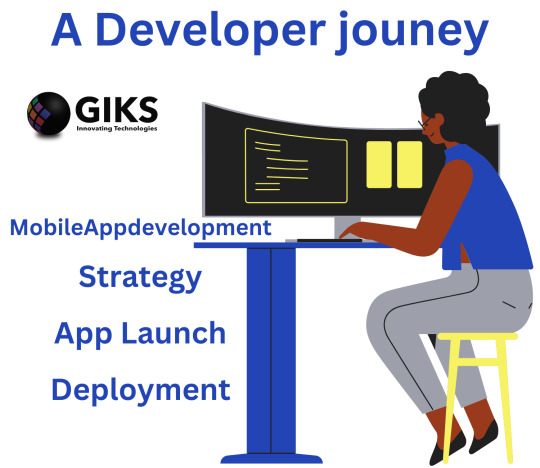
Embarking on Your Developer's Journey: A Step-By-Step Guide
The world of software development is a realm of endless creativity, innovation, and problem-solving. Whether you're just starting out or looking to transition into a tech career, embarking on your developer's journey is an exciting endeavor. From learning the fundamentals to mastering advanced concepts, this step-by-step guide will help you navigate the path to becoming a skilled developer.
Step 1: Define Your Path
Begin by clarifying your goals. Are you interested in frontend or backend development? Mobile apps or web applications? Defining your focus will guide your learning journey.
Step 2: Choose a Programming Language
Select a programming language aligned with your chosen path. For web development, consider languages like HTML, CSS, and JavaScript. For backend development, explore options like Python, Ruby, or Java.
Step 3: Learn the Basics
Start with the basics. Online platforms, coding bootcamps, and tutorials offer beginner-friendly resources to help you grasp programming concepts, syntax, and logic.
Step 4: Build Small Projects
Apply what you've learned by building small projects. These could be simple websites, calculators, or basic apps. Practice is key to solidify your understanding.
Step 5: Explore Frameworks
Frameworks simplify development. For web development, explore frontend frameworks like React or backend frameworks like Django and Ruby on Rails.
Step 6: Version Control with Git
Git is essential for collaboration and version control. Learn the basics of Git and platforms like GitHub to manage your projects effectively.
Step 7: Dive Deeper
As you gain confidence, delve into more advanced topics. Learn about databases, APIs, authentication, and other crucial concepts relevant to your chosen path.
Step 8: Solve Real-world Problems
Challenge yourself with real-world problems. Platforms like LeetCode and HackerRank offer coding challenges that enhance your problem-solving skills.
Step 9: Collaborate and Network
Join coding communities, forums, and meetups. Networking helps you learn from others, get feedback, and stay updated on industry trends.
Step 10: Build a Portfolio
Create a portfolio showcasing your projects. A strong portfolio demonstrates your skills and makes you stand out to potential employers.
Step 11: Seek Internships or Freelance Work
Apply your skills in real-world scenarios through internships or freelance work. Practical experience is invaluable for your growth as a developer.
Step 12: Keep Learning
Technology evolves rapidly. Stay curious and continue learning about new languages, tools, and trends to remain relevant in the field.
Step 13: Specialize
As you gain experience, consider specializing in a niche area like mobile app development, machine learning, or cybersecurity.
Step 14: Contribute to Open Source
Contributing to open-source projects enhances your skills, connects you with the community, and boosts your resume.
Step 15: Stay Adaptable
Adaptability is key in tech. Embrace change, continuously update your skills, and be open to learning new technologies.
In Conclusion
Embarking on your developer's journey requires dedication, perseverance, and a thirst for learning. Remember, every coder started as a beginner. By following this step-by-step guide, you'll lay a strong foundation for your growth as a developer. Stay curious, build, collaborate, and continuously improve – your journey has just begun.
For more information go to my blog website.
2 notes
·
View notes
Text
Top Tools and Technologies Every Full Stack Java Developer Should Know
In today's fast-paced software development landscape, Full Stack Java Developers are in high demand. Companies seek professionals who can work across both the frontend and backend, manage databases, and understand deployment processes. Whether you're just starting your career or planning to upskill, mastering the right set of tools and technologies is key.
If you're considering a full stack java training in KPHB, this guide will help you understand the essential technologies and tools you should focus on to become industry-ready.

1. Java and Spring Framework
The foundation of full stack Java development starts with a deep understanding of Core Java and object-oriented programming concepts. Once you’ve nailed the basics, move to:
Spring Core
Spring Boot – simplifies microservices development.
Spring MVC – for building web applications.
Spring Security – for handling authentication and authorization.
Spring Data JPA – for database operations.
Spring Boot is the most widely adopted framework for backend development in enterprise applications.
2. Frontend Technologies
A full stack Java developer must be proficient in creating responsive and interactive UIs. Core frontend technologies include:
HTML5 / CSS3 / JavaScript
Bootstrap – for responsive designs.
React.js or Angular – for building dynamic SPAs (Single Page Applications).
TypeScript – especially useful when working with Angular.
3. Database Management
You’ll need to work with both relational and non-relational databases:
MySQL / PostgreSQL – popular SQL databases.
MongoDB – a widely used NoSQL database.
Hibernate ORM – simplifies database interaction in Java.
4. Version Control and Collaboration
Version control systems are crucial for working in teams and managing code history:
Git – the most essential tool for source control.
GitHub / GitLab / Bitbucket – platforms for repository hosting and collaboration.
5. DevOps and Deployment Tools
Understanding basic DevOps is vital for modern full stack roles:
Docker – for containerizing applications.
Jenkins – for continuous integration and delivery.
Maven / Gradle – for project build and dependency management.
AWS / Azure – cloud platforms for hosting full stack applications.
6. API Development and Testing
Full stack developers should know how to develop and consume APIs:
RESTful API – commonly used for client-server communication.
Postman – for testing APIs.
Swagger – for API documentation.
7. Unit Testing Frameworks
Testing is crucial for bug-free code. Key testing tools include:
JUnit – for unit testing Java code.
Mockito – for mocking dependencies in tests.
Selenium / Playwright – for automated UI testing.
8. Project Management and Communication
Agile and collaboration tools help manage tasks and teamwork:
JIRA / Trello – for task and sprint management.
Slack / Microsoft Teams – for communication.
Final Thoughts
Learning these tools and technologies can position you as a highly capable Full Stack Java Developer. If you're serious about a career in this field, structured learning can make all the difference.
Looking for expert-led Full Stack Java Training in KPHB? ✅ Get industry-ready with hands-on projects. ✅ Learn from experienced instructors. ✅ Job assistance and certification included.
👉 Visit our website to explore course details, check out FAQs, and kickstart your journey today!
0 notes
Text
Fantasy Cricket App Development: Build the Ultimate App Before the Upcoming Cricket Series 2025
The buzz around fantasy cricket app development is louder than ever as cricket fans across the globe prepare for the upcoming cricket series in 2025, including the India vs Australia bilateral series, Asia Cup 2025, and the much-anticipated T20 World Cup 2025. With millions of users participating in online fantasy leagues, developing a fantasy cricket app is not just a trend—it's a smart business move.
Whether you're a startup, sports enthusiast, or entrepreneur looking to tap into the lucrative world of fantasy sports, now is the ideal time to invest in a fantasy cricket app tailored for the upcoming tournaments.
What is Fantasy Cricket App Development?
Fantasy cricket app development involves creating a digital platform (mobile or web-based) where users form their own virtual cricket teams from real-life players and score points based on players' actual performances in live matches. The better their selected players perform, the more points users earn and the higher their chances of winning real rewards.
A fantasy cricket app should offer a seamless and engaging user experience, real-time data, secure transactions, and features that align with the user intent of cricket lovers: real-time gameplay, rewards, excitement, and community engagement.
Why Fantasy Cricket App Development is Booming in 2025
With upcoming cricket events like the Asia Cup 2025, T20 World Cup 2025, IPL 2025, and India vs Australia series, the fantasy sports industry is set to see a record-breaking number of users. Here’s why this is the perfect time to launch your app:
📈 Rapid User Growth: India alone has over 150 million fantasy sports users.
🏏 High Cricket Engagement: Users spend hours analyzing and picking teams.
💡 Advanced Tech Options: APIs, AI-powered analytics, and real-time updates are easily available.
💰 Profit-Driven Model: Revenue from entry fees, ads, and in-app purchases.
🔐 Secure Legal Framework: Fantasy sports are legally allowed as games of skill in India and many other countries.
Key Features of a High-Performance Fantasy Cricket App
To compete with the big names like Dream11, My11Circle, and MPL, your fantasy cricket app must include:
✅ User Panel Features:
Quick registration/login via email or mobile
Real-time match stats and score updates
User-friendly interface and leaderboard
Multiple contest types (free, paid, private)
Instant wallet integration (deposit/withdrawal)
🛠️ Admin Panel Features:
Manage users, contests, payments, and referrals
Monitor player performance and scoring systems
Handle complaints and support tickets
Push notifications and analytics dashboard
Fantasy Cricket App Development Cost in 2025
The fantasy cricket app development cost varies based on complexity, features, and design. Here's a rough breakdown:
Basic App (Android/iOS): ₹3,00,000 – ₹6,00,000
Mid-level App (Custom UI/UX + Real-time Stats): ₹6,00,000 – ₹10,00,000
Advanced App (Multi-sport, AI, Global Support): ₹10,00,000 – ₹20,00,000+
Working with a professional fantasy sports app development company like IMG Global Infotech ensures a secure, fast, and feature-rich application.
Monetization Strategies for Fantasy Cricket Apps
Wondering how to make money from a fantasy cricket app? These proven methods drive revenue:
💸 Entry Fees for Paid Contests
📊 In-app Advertisements (Google AdMob, Facebook Ads)
🏷️ Premium Memberships
🤝 Sponsorships and Brand Collaborations
📈 Affiliate Marketing and Referrals
Best Technology Stack for Fantasy App Development
To develop a robust, scalable fantasy app, you need a modern and reliable tech stack:
Frontend: React Native, Flutter (for cross-platform)
Backend: Node.js, Laravel, Python (for fast performance)
Database: MongoDB, PostgreSQL
APIs: Cricket Score API (CricAPI, SportsRadar), Payment Gateway (Razorpay, Paytm)
Why Choose IMG Global Infotech for Fantasy Cricket App Development?
IMG Global Infotech is one of the most trusted names in fantasy cricket app development in India, offering customized and scalable fantasy sports solutions. Whether you're building an app like Dream11 or want a unique concept, they deliver:
✅ Seamless user experience
✅ Real-time data sync
✅ Custom contests and AI-based recommendations
✅ Secure wallet system
✅ Post-launch technical support
Their experience in delivering high-performance fantasy cricket apps makes them the preferred choice for entrepreneurs and startups in the fantasy gaming space.
Semantic SEO & Conversational Keywords to Use
When optimizing your site or app page, include the following semantic SEO keywords to improve visibility and ranking:
fantasy cricket app development company
best fantasy cricket app developers
build a fantasy cricket app like Dream11
fantasy sports app solutions India
cost to develop fantasy cricket app
create fantasy app for IPL 2025
fantasy sports app development guide
These keywords match what users are actively searching for in 2025 and help improve topical relevance and search intent targeting.
FAQs – Fantasy Cricket App Development 2025
Q1. Can I create a fantasy cricket app before IPL or T20 World Cup 2025? Yes, this is the ideal time to launch your app before the upcoming cricket events. It ensures maximum user engagement.
Q2. Is fantasy cricket legal in India? Yes, fantasy cricket is considered a game of skill and is legal in most Indian states.
Q3. What is the revenue model of fantasy cricket apps? Fantasy apps earn via contest entry fees, ads, premium plans, and brand sponsorships.
Q4. How long does it take to develop a fantasy cricket app? Basic apps take 2–3 months, while advanced platforms may take 4–6 months depending on features.
Q5. Which company is best for fantasy cricket app development? IMG Global Infotech is highly recommended for fantasy cricket app development with a strong portfolio and custom features.
Final Thoughts
With the T20 World Cup 2025, IPL 2025, and Asia Cup on the horizon, there's never been a better time to invest in fantasy cricket app development. By partnering with expert developers like IMG Global Infotech, you can launch a feature-rich, profitable app that captures the excitement of cricket and turns fans into daily users.
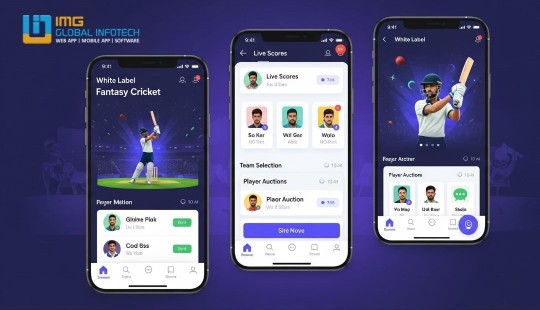
#fantasy cricket app development#fantasy cricket app development company#fantasy cricket app development company in india#fantasy cricket app development cost#fantasy cricket app#app like dream11#img global infotech
1 note
·
View note
Text
Frontend vs Backend vs Fullstack: What Should You Learn First?
If you’re thinking about stepping into the world of web development, you’ve probably come across the terms frontend, backend, and fullstack. These are the three main paths in web development, and figuring out where to start can feel overwhelming—especially if you’re just getting started.
The good news? There’s no one-size-fits-all answer. It all depends on your interests, goals, and the kind of projects you want to build. But to help you make a more informed choice, let’s break down what each role involves and what makes one the right starting point for you.
What is Frontend Development?
Frontend development is everything you see and interact with on a website or web application. The layout, colors, fonts, buttons, animations, and responsiveness—all of that is created by frontend developers.
They use technologies like HTML, CSS, and JavaScript, often alongside frameworks like React, Vue, or Angular. It’s a creative and visual role, but it also involves logic and problem-solving.
If you enjoy design, user experience, or the idea of building interfaces that people directly use, frontend might be the perfect entry point.
What is Backend Development?
While the frontend is what users see, the backend is what makes everything work behind the scenes. It’s the part of a web application that handles data, user authentication, server communication, databases, and APIs.
Backend developers typically work with languages like Java, Python, Node.js, or PHP, and frameworks like Spring Boot or Django. They’re responsible for making sure that when a user clicks “submit,” the data gets stored securely, processed correctly, and returned properly.
If you enjoy logic, systems, databases, and working on the technical backbone of applications, backend development could be the better starting point.
What is Fullstack Development?
Fullstack developers work on both frontend and backend. They understand how to build entire applications from start to finish, including the user interface and the server-side logic.
Fullstack development is ideal if you want to be more versatile or work independently (like in startups or freelance projects). You’ll need to learn both sets of skills, which can take more time—but the payoff is that you’ll have a broader skillset and more flexibility in the job market.
Which Should You Learn First?
Now that you understand the roles, the big question is: where should you begin?
If you’re someone who likes visual results and immediate feedback, frontend is usually a great starting point. It’s beginner-friendly and helps you see your progress quickly. You can build your first webpage in just a day or two, which keeps motivation high.
If you’re more interested in how systems work, enjoy working with data, or have a background in programming or logic-based tasks, backend might be a more natural starting place. It might feel a bit more abstract in the beginning, but it's deeply rewarding.
Fullstack is best tackled once you have a grasp on either frontend or backend first. Once you're comfortable with one, adding the other side of development becomes easier and more meaningful.
A Tip for Beginners
Many developers start with frontend, learn the basics of how websites look and behave, then move into backend to understand how to handle data and business logic. This route builds a strong foundation and makes learning fullstack development feel more achievable.
No matter which path you choose first, you're not locked in. Skills are transferable, and the tech industry values flexibility and continuous learning.
Where to Learn?
If you're looking to build a career in this field and want guidance from industry experts, consider enrolling in a hands-on, project-based web development course in Pune. Whether you want to specialize in frontend, backend, or eventually become a fullstack developer, structured learning with real-world projects will make a huge difference in how fast and effectively you grow.
Final Thoughts
Frontend, backend, or fullstack—it all comes down to what excites you the most. There's no wrong place to start. What's important is that you start. And in today’s digital-first world, web development is one of the most rewarding and future-proof skills you can have.
So go ahead, take that first step. Learn, build, experiment—and soon enough, you’ll be creating websites and applications that people around the world use every day.
0 notes
Text
Crafting the Future with a Website Development Company: A Deep Dive into Modern Digital Solutions

In the digital-first age, businesses are evolving rapidly to meet consumer demands. At the heart of this evolution is the increasing reliance on a website development company to craft digital platforms that are not only visually appealing but also functionally robust. The demand for such specialized services continues to grow, driven by the need for seamless online experiences, faster response times, and mobile-friendly interfaces.
Let’s explore the role of a website development company in today’s market, the essential support provided by web development services, and why hiring a ui ux design agency in Mumbai or searching for website developers near me is becoming the go-to solution for businesses of all sizes.
The Rise of the Website Development Company
A website is more than just an online brochure. It’s a dynamic platform that can drive engagement, convert leads, and reflect a brand’s identity. That’s why partnering with a professional website development company is no longer optional — it’s essential.
Such companies bring a team of skilled developers, designers, strategists, and project managers together to execute a vision from concept to code. They ensure the site is fast-loading, secure, optimized for all devices, and capable of integrating with third-party tools and platforms as needed. Their holistic approach means that every website is designed with scalability, user experience, and performance in mind.
Understanding the Core of Web Development Services
At the core of any digital transformation project lies comprehensive web development services. These services go beyond basic website building. They include backend programming, frontend interface design, API integrations, database configuration, server management, and more.
A robust web development service ensures that a website functions seamlessly under various conditions — be it high traffic volumes, dynamic content updates, or e-commerce transactions. Moreover, these services often come with maintenance packages to handle bugs, updates, and cybersecurity threats post-launch.
With businesses focusing more on data security and personalized user journeys, investing in high-quality web development services has become a priority.
Why Location Matters: Searching for Website Developers Near Me
With the rise of remote work and global collaboration, you might wonder if location still matters when hiring a development team. Interestingly, many business owners and project managers still prefer to search for website developers near me for several reasons.
Firstly, local developers provide better contextual understanding of your audience and regional market dynamics. Secondly, working in similar time zones enables faster communication and more efficient meetings. Thirdly, face-to-face collaboration — whether virtual or in-person — can often improve project outcomes by reducing misunderstandings.
Moreover, local developers can assist with compliance to regional laws, especially regarding user data protection, and can provide quicker support if urgent issues arise.
The Strategic Role of a Web Development Agency
While freelancers or in-house teams might seem like viable options, a dedicated web development agency brings its own unique strengths to the table.
An agency typically has years of experience across various industries and technologies. Their teams are specialized, allowing them to deliver faster and more efficiently than an individual or small team could. This means the project benefits from expert frontend developers, experienced backend engineers, seasoned project managers, and talented designers — all working in unison.

Enhancing Digital Experiences with a UI UX Design Agency in Mumbai
A well-developed website is only as good as the user experience it provides. This is where a ui ux design agency in Mumbai comes into the picture. Mumbai, being a melting pot of creativity and commerce, has seen a surge in high-caliber design talent focused on solving real-world usability problems.
A specialized agency in UI and UX focuses on how users interact with a site. They conduct extensive user research, create intuitive navigation structures, and test interface elements to ensure that the end product feels seamless and enjoyable to use. These agencies blend data with creativity, ensuring that visual appeal never compromises function.
Their contribution becomes even more valuable in high-stakes sectors like fintech, healthcare, or e-commerce, where a slight friction in user experience can lead to massive drop-offs in engagement or conversion.
How to Choose the Right Website Development Company
With so many options available, choosing the right website development company can be overwhelming. Here are a few points to consider during selection:
Portfolio and past work: Review their previous projects to evaluate quality and diversity.
Technical stack: Ensure they are proficient in the technologies best suited to your project.
Communication and transparency: Regular updates and open channels of communication are vital.
Scalability and support: Choose a team that offers post-launch support and the ability to scale your website as your business grows.
UI/UX capabilities: A development company that integrates design thinking into the process delivers better results.
By paying attention to these factors, you can avoid common pitfalls and ensure the success of your digital product.
Trends Shaping the Future of Web Development
As technology advances, the role of a website development company is also evolving. Here are a few key trends to watch:
Progressive Web Apps (PWAs): These provide app-like experiences directly within browsers.
Headless CMS: Offers greater flexibility in managing content across multiple platforms.
Voice Search Optimization: Websites are increasingly being optimized for voice-based interactions.
AI and Chatbots: Enhancing user interaction and providing instant support.
Dark Mode & Accessibility: Design elements that cater to user preferences and inclusivity.
By aligning your website strategy with these trends, you can stay ahead in a competitive digital landscape.
The Cost vs. Value Dilemma
It’s common to evaluate a website development project in terms of upfront cost. However, the true value lies in long-term ROI — customer acquisition, retention, lead generation, and user engagement. A professional web development agency doesn’t just deliver code; they deliver growth.
Investing in comprehensive web development services ensures that your site is built to perform under pressure, evolve with technology, and meet the expectations of an increasingly tech-savvy user base.
Conclusion: A Smart Partnership for Long-Term Growth
Partnering with a professional website development company is not just about getting a website — it’s about building a foundation for digital success. With comprehensive web development services, strategic input from a web development agency, and design excellence offered by a ui ux design agency in Mumbai, businesses are empowered to compete at a higher level.
Whether you’re searching for website developers near me for localized support or looking to scale your online presence globally, the key is to choose a team that understands your vision and has the expertise to bring it to life.
In today’s competitive landscape, a website is more than just a digital footprint. It is your brand, your store, your office, and your voice — all rolled into one. By making the right choice now, you set the stage for sustained growth, improved customer engagement, and long-term digital transformation.
#website development company#web development services#ui ux design agency in mumbai#website developers near me#web development agency
0 notes
Text
Unlocking Full-Stack Development: A Comprehensive Roadmap for Aspiring Developers in India
In the era of digital transformation, the demand for skilled full-stack developers in India is soaring. These versatile professionals proficient in both frontend and backend development are essential for building dynamic web applications. If you're aspiring to become a full-stack developer in India, this comprehensive roadmap will guide you through the steps to achieve your goal.

1. Grasp the Essentials of Web Development: To kickstart your journey as a full-stack developer, begin by mastering the core concepts of web development. Dive into HTML, CSS, and JavaScript—the fundamental languages for creating web pages. Understanding these basics lays a solid foundation for your future endeavors.
2. Select a Backend Language and Framework: Once you're comfortable with frontend technologies, delve into backend development by choosing a programming language and framework. Options like Python with Django, JavaScript with Node.js, or Ruby with Ruby on Rails are popular choices. These backend technologies empower you to handle server-side logic and data management efficiently.
3. Acquire Proficiency in Database Management: Database management is a critical aspect of full-stack development. Familiarize yourself with database systems such as MySQL, PostgreSQL, or MongoDB. Learn database querying, indexing, and normalization to effectively store and retrieve data for your web applications.
4. Explore Frontend Frameworks and Libraries: Enhance your frontend development skills by mastering popular frameworks and libraries. React.js, Angular, and Vue.js are widely used for building dynamic user interfaces. Dive deep into these tools to create interactive components and manage application state seamlessly.
5. Embrace Version Control Systems: Version control is indispensable for collaborative software development. Get hands-on experience with Git and platforms like GitHub or GitLab. Learn to create repositories, commit changes, and collaborate with other developers to streamline your workflow.
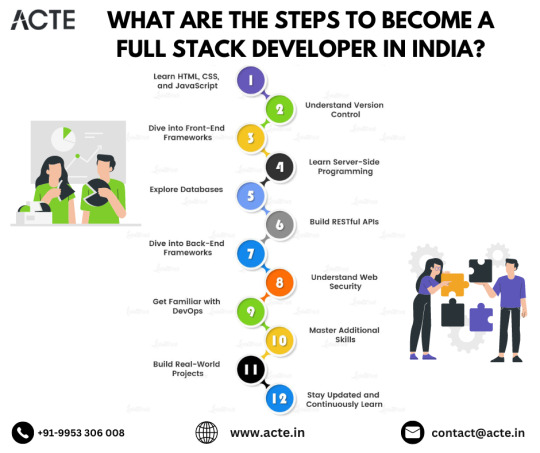
6. Sharpen Your Problem-Solving Skills: Problem-solving is a core competency for any developer. Practice solving coding challenges and algorithms on platforms such as LeetCode, HackerRank, or CodeSignal. Strengthening your problem-solving abilities will prepare you for technical interviews and real-world coding scenarios.
7. Develop Projects and Build a Portfolio: Apply your knowledge by working on diverse projects that showcase your full-stack development skills. Start with simple projects and gradually tackle more complex ones to demonstrate your proficiency. Create a portfolio website to exhibit your projects, expertise, and accomplishments to potential employers.
8. Stay Abreast of Industry Trends: The tech landscape evolves rapidly, so it's crucial to stay updated with the latest trends and technologies. Attend tech meetups, workshops, and conferences to network with industry professionals and learn from their experiences. Follow influential blogs, podcasts, and social media channels to stay informed about emerging trends and best practices.
9. Pursue Internship Opportunities: Internships provide invaluable hands-on experience and exposure to real-world projects. Look for internship opportunities at companies or startups where you can apply your skills in a professional environment. Internships also offer opportunities for mentorship and networking, which can be invaluable for your career growth.
10. Cultivate a Continuous Learning Mindset: Becoming a full-stack developer is a journey of lifelong learning and growth. Stay curious, explore new technologies, and continuously expand your skill set. Be open to adapting to new challenges and opportunities as they arise, and embrace a growth mindset to thrive in the ever-evolving tech industry.
Conclusion: Mastering full-stack development in India requires dedication, perseverance, and a commitment to lifelong learning. By following this comprehensive roadmap, you can acquire the skills and knowledge needed to excel in this dynamic and rewarding field. So, roll up your sleeves, embark on your full-stack development journey, and unlock a world of endless possibilities in India's thriving tech ecosystem.
#full stack developer#information#education#front end development#full stack web development#full stack developer course#frameworks#backend#technology#web development
2 notes
·
View notes